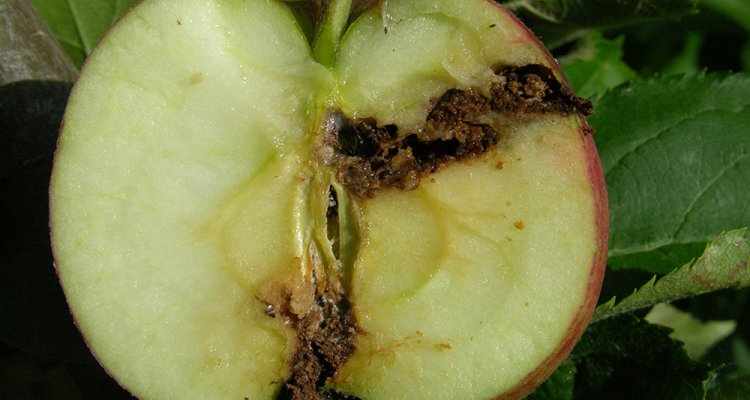
Project
End user plays decisive role when developing and distributing new crop protection agents against diseases and pests
Fruit researchers from Wageningen University & Research (WUR) are taking part in the European ‘EMPHASIS’ project. The purpose of EMPHASIS is to improve the combat of native and alien diseases, pests and weeds in both natural ecosystems as well as in existing cropping systems. In this project, WUR researchers will focus on the pests of Chalara fraxinea (ash dieback) and Cydia pomonella (codling moth).
Better and more sustainable crop protection strategies improve food safety without endangering ecosystems. The aim of the project is to achieve proper understanding between researchers and end users so that the project results are of actual relevance for end users.
Ash dieback and codling moth
As part of the EMPHASIS project, WUR will provide practical knowledge regarding environmentally friendly solutions for detecting and combating diseases and pests. WUR will focus on two specific types of pests. Chalara fraxinea is a fungus which causes ash dieback and which has already resulted in significant forest loss. In Lithuania, for example, the size of the area covered by ash forests shrunk from 53,000 hectares in 2001 to 38,000 hectares in 2009 and in Denmark they have even stopped planting ash trees altogether. EMPHASIS will be looking for ash varieties that are resistant to Chalara fraxinea.
The second type of pest on which WUR researchers will focus is the codling moth (Cydia pomonella). The larvae of this moth bore into the fruits of trees such as apple, pear and walnut and are resistant to certain forms of pesticide. An alternative crop protection application is being developed to actively spray pheromones produced by female codling moths at just the right moment instead of using passive dispensers which make it difficult to choose the exact moment of application. WUR will examine how successful this mating disruption method is.
Goals
The general objective is to provide innovative yet practical solutions and products for the purpose of predicting, preventing and tackling infestations. These solutions and products must generate economic benefits without causing harm or additional harm to the environment. The effectiveness of these solutions and products will be assessed, validated and communicated through close cooperation with end users.
In the search for new methods of combating Chalara fraxinea and Cydia pomonella, the general aim is to:
- Achieve shared understanding between researchers and interested parties. This ensures that the research carried out is of actual relevance for the end users.
- Convert the research results into practical solutions for integrated crop protection (Integrated Pest Management, IPM). Field trials on location and the testing of aids will lead to solutions that can be put to immediate use.
- Increase research and development activities. Innovations will be directly implemented, which means that they will be of immediate relevance in the market and in society, and research and development will be able to continue without delay.
Approach
The initial step is to start or continue developing the practical solution or product on a small scale. The second step is to optimise the solution or product in cooperation between the researchers and end users. The demonstrations given to end users of practical solutions are of particular importance during this step. This enables feedback to be given and a bottom-up approach is created in which the wishes of the end users determine project content.
To facilitate this interactive approach, the following tasks are carried out:
- Small-scale tests for the purpose of selecting new and interesting resistant varieties, optimising the effectiveness of products or developing new techniques or products.
- Field trials on location for the purpose of testing and adjusting potential solutions for combating pests and diseases once they have proven to be effective on a small scale.
- Field training with the farmers, growers and greenery managers. Since the end users themselves are involved in the solution, this will result in greater support. In addition, the end users will explain to others how the new solutions work and how they are meant to be used. In this way, the end users will have some say in determining the best way to explain these solutions. This is beneficial as other end users will more readily accept advice from colleagues than from advisors and/or researchers.
- Innovation management and product development. Business plans will be drawn up to make innovations quickly available to everybody.
The specific focus topics of the WUR researchers will be dealt with as follows:
- With regard to ash dieback (Chalara fraxinea), researchers will look for ash varieties that are not susceptible to Chalara fraxinea infections. All available ash varieties will be tested for resistance to Chalara fraxinea. The seeds of the most resistant varieties will be collected and stored for further testing in future research and will eventually be brought onto the market.
- Combating Cydia pomonella with pheromones depends on how well the pheromone diffusers work. WUR will focus on diffuser types, the number of diffusers per hectare, and the quantity and timing of released pheromones, depending on different weather conditions and positions in the field.
Results
Reports will be drawn up for all tests so that new protection strategies will eventually be made available for the purpose of preventing ash dieback and codling moth infestations. In addition, ready-to-use business plans will ensure proper dissemination of the innovations that are developed, taking into consideration commercial interests as well as the interests of end users.